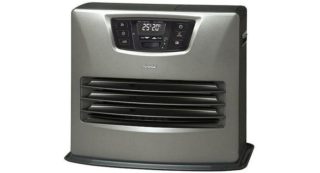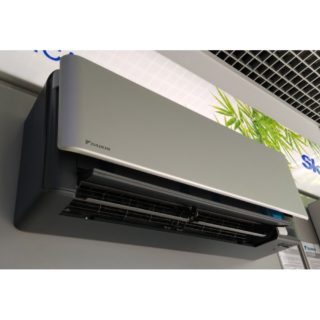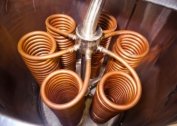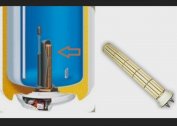An inverter is a device capable of converting direct current into alternating current with a change in voltage. IPBs are built into any electrical installations to protect them from power surges. Inverter heater - a model in which the inverter is connected with temperature control and power regulation.
Main characteristics
The installation converts the incoming alternating current into direct current, and then again converts the direct current into alternating current, but with different characteristics. As a result, the device does not work with mains electricity, but with current with improved performance. This eliminates damage to the apparatus during power surges: the heater lasts longer and works with greater efficiency.
The scheme of work is also changing. An ordinary heater, when turned on, heats the air to the specified temperature, and when it is reached it completely turns off. When the sensor signals a decrease in temperature in the room, the device turns on again. However, starting up the instrument causes a short peak load. This mode contributes to the rapid wear of parts.
The inverter heater for the home acts differently. When turned on, the heater heats the air to the specified temperature, but after reaching it it does not turn off, but reduces the power output to 5–10%. When the temperature drops below the marked value, the heater increases the power.
In this mode, the power gradually increases and decreases, and there are no peak loads. The temperature also changes more smoothly, which allows to increase the shutdown time and reduce electricity consumption.
Advantages and disadvantages
The inverter heater provides the following benefits:
- high performance - the mode without peak loads provides constant temperature in the room;
- profitability - due to the lack of restart, the inverter heater saves up to 40% of electricity;
- noiselessness - at low power the rotation speed decreases, and the device does not create noise;
- material - steel, aluminum alloy, another metal, does not matter;
- durability - the heater undergoes less wear and lasts longer.
There are also disadvantages:
- the price of such models is higher for the same power indicators;
- details are non-standard - repairs require a lot of time;
- the inverter does not protect against sudden changes in voltage.
Installation of inverter heaters of any type does not require permission.
Varieties of inverter heater
The inverter is able to change the characteristics of the heater, if the latter has electronic control. Actually, the design of the heater does not matter. But since the technology is expensive, they install the unit on high-end models.
Gas
Such heaters operate on natural or liquefied gas. Since it is cheap fuel, heating a room costs only a little more than when using water heating. It is intended for heating large areas, perfect for summer cottages.
Inverter technology increases the efficiency of the device. The burning rate of the burner changes smoothly, which eliminates the risk of extinguishing the flame. Fuel is consumed even more economically. Inverter units are more compact than conventional gas heaters.
Infrared
Heating elements emit infrared radiation - this is a plus. In this case, not the air in the room is heated, but surfaces, objects and people. This allows for comfort at virtually lower temperatures.
The heater works in the same way as the others: it turns on when the temperature drops and turns off when it rises. Inverter electric infrared heater works without shutdowns, only reduces the intensity of heating. The device consumes much less electricity with high heat transfer. This is important because electricity is expensive.
With heat pumps
This refers to air conditioners that can operate in reverse mode - not only for cooling, but also for heating. The fan pumps cold air from the outside, but since the temperature of the refrigerant is still much lower, the latter boils, and at the compression stage it condenses with heat transfer. Through the heat exchanger, heat is transferred to the air in the room. Thus, an air conditioner with a heat pump receives heat from air with a temperature of up to 0 C.
Such a system is cheaper than an electric heater. The inverter unit makes the air conditioner even more economical. When the desired temperature is reached, it does not completely turn off the installation, but switches to minimum power mode. Without peak loads, the device lasts longer and consumes less power.
Convectors
Install the inverter in electric convectors. Such models are represented by Electrolux and Bally. The principle is the same: the unit does not turn off the device, but reduces power. The heater works in maintenance mode most of the time. At the same time, it consumes less electricity and wears out less.
In this mode, the heating elements are heated to a lesser extent, and oxygen is burned less. Inverter convectors are safer for health.
Heater selection
In terms of functions and appearance, inverter heaters are no different from ordinary ones. Is that gas models are somewhat smaller in size. The selection recommendations relate not so much to the purpose of the heater as to an assessment of its quality. Pay attention to the following:
- quality certificates - a certificate is necessarily attached to the inverter device;
- series number — special symbols and numbers indicate the origin of the device in the labeling of each product;
- reliability of contacts;
- CE marking - indicates the safety of the product for human health - so mark devices that comply with EU standards;
- wires - to prevent a fire during a short circuit or damage, the wires for the heater are made of materials that do not support combustion - when ignited, they smolder for several seconds, go out and melt the center of short circuit.
Which of the inverter modules is needed - a converter, an infrared heater, a heat pump - is decided based on the area of the room, convenience, and savings.
Terms of Use
Recommendations on the use of heaters extend their life. The rules are simple:
- Do not install the heater near furniture or a wall - no closer than 50 cm;
- they do not recommend leaving the heater on for the whole night - this can only be done if it is equipped with a thermostat that determines the operating and shutdown times;
- Do not place heaters under the window opening;
- it is forbidden to dry things on them.
In case of any kind of malfunction, it is necessary to turn off the device and contact a service center.
Popular manufacturers
Manufacturers of inverter heaters are only slightly less than manufacturers of heating appliances. The technology is actively used in the production of devices of both the elite and the middle class.
Daikin
This company was the first to offer inverter air conditioners on the market. Split systems work silently, purify the air thanks to multi-stage filtration. Some models are equipped with energy-saving sensors. If the device does not fix thermal objects, in the room after 20 minutes it automatically goes into economy mode.
Toshiba
The most popular brand. Air conditioners are reliable, practical, reach the set temperature 25% faster than any other device. At the same time, energy consumption does not increase.
Toshiba devices are equipped with multi-stage filters and guarantee air purification by 95%.









